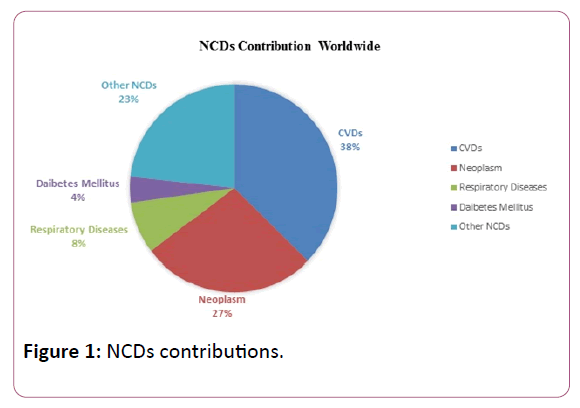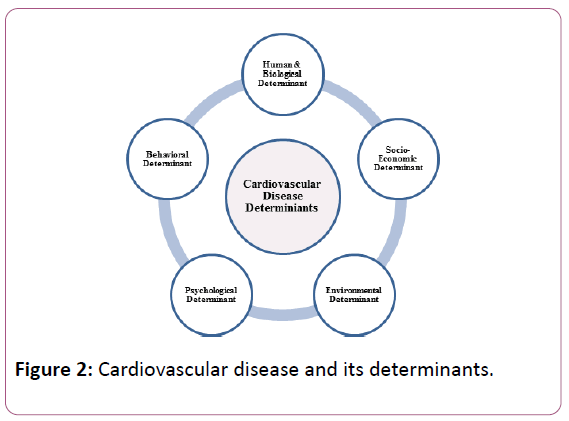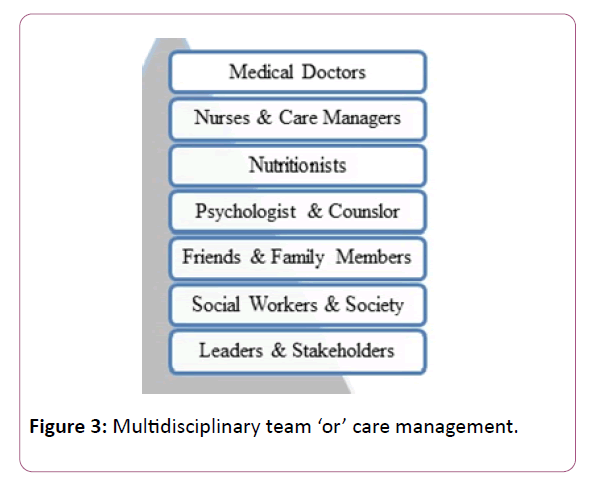Cardiovascular Disease and Its Determinants: Public Health Issue
Santosh Kumar*
School of Nursing and Midwifery, Aga Khan University, Karachi, Pakistan
- *Corresponding Author:
- Kumar S
School of Nursing and Midwifery
Aga Khan University
Karachi, Pakistan
Tel: +92 333-3267825
E-mail: santoshkumarpak@gmail.com
Received Date: December 08, 2016; Accepted Date: December 29, 2016; Published Date: January 05, 2017
Citation: Kumar S. Cardiovascular Disease and Its Determinants: Public Health Issue. J Clin Med Ther. 2017, 2:1.
Copyright: © 2017 Kumar S. This is an open-access article distributed under the terms of the Creative Commons Attribution License, which permits unrestricted use, distribution and reproduction in any medium, provided the original author and source are credited.
Abstract
Cardiovascular Disease (CVD) is the leading cause of deaths and its incidence is rapidly increasing in every region of the world. It remains a major threat to the modern society. In 2008, more than 17 million people died from CVD, and more than three millions of these deaths occurred before the age of 60 years that could be prevented. The Global Burden of Disease Study (2013) estimated that almost 30% of all deaths worldwide were caused by CVD. At present, CVD prevention becomes a major issue for world health, and the burden and risk factors remain alarmingly high. The magnitude of CVD continues to accelerate globally as a result of increasing various risk factors or determinants but these can be controlled, modified, and treated if certain steps can be taken and followed. Moreover, increased incidence of chronic diseases including CVD is one of the most important challenges for the health system throughout the countries. CVD is largely preventable if populationwide measures and access to individual health care become possible for the people. In this paper, I will discuss the CVD, its prevalence, critically identify and analyze the determinants of the cardiovascular disease, followed by multidisciplinary team or care management approach and ends with recommendation and conclusion.
Keywords
Cardiovascular disease; Determinants; Health care system; Pakistan; Risk factors
Scenario
Miss Roselean Joseph (Pseudo name) is a 49 years divorced woman, who has been diagnosed with cardiovascular disease (CVD) and living in a small house at the town of Sindh, Pakistan with her 26 years old daughter. She is overweight and smoked a half pack a day for the last 14 years. Miss Roselean Joseph has resigned from the job at the private school due to disease, and her daughter works as a receptionist at a hospital. The Roselean Joseph lives in the area which is considered as “food desert” for its absence of markets that supply fresh healthy food items and have poor health facilities. Roselean Joseph knows that she should exercise but having no space at home, no sidewalks, and no gymnasium where they live and cultural boundaries for female restrict them from the physical activities. Moreover, due to lack of local supermarket and her daughter busy work schedule Roselean Joseph prefer to eat outside where local fast food is available at cheaper rate. When Roselean Joseph gets the nearest market finds snacks, and fries are cheaper than vegetables and fruits. Roselean Joseph knows that vegetables and fruits are better but every time cannot afford due to her financial conditions. As a Health Professionals, we know this scenario is common and comes in many variations. However, we can see the role of Roselean Joseph in personal choice of CVD and will identify and analyze the determinants of CVD.
Introduction
Cardiovascular Disease is a major cause of disability and premature death throughout the world and it substantially contributes to the escalating costs of health care, mortality, and morbidity. CVD is also known as heart and blood vessels disease having an average of one death occurring at every 42 s [1].
Globally, CVD is becoming crisis and major cause of morbidity and mortality in every region of the world with the exceptions of sub-Saharan Africa, where infectious diseases are still the leading cause of death and South Korea and Japan, where cancers cause more deaths [2].
Throughout the world, it is the major public health problem that is dominated by death statistics in last few decades and accounts for nearly half of non-communicable disease [3]. The CVD can affect individuals from different countries, background, age, gender, race, and income groups. There is a misconception about CVD that it is the problem of rich population. In fact, it is the leading cause of death, disability, and adjusted life worldwide. It could be prevented through population-based strategies, and by making cost-effective interventions accessible and affordable, both for people with established disease and for those at high risk of developing the CVD.
Prevalence of the Cardiovascular Diseases
Cardiovascular Disease accounts for one-half of all NCD deaths in the world. The statistics indicate that CVD account for 17.3 million yearly deaths, and this amount is likely to raise up to 23.6 million by the end of 2030 [4]. The proportions of the deaths under the age 65 are mentioned in the Table 1. Furthermore, the contribution of CVD among the NCDs is mentioned in the Figure 1. Recent shreds of evidence of different studies have shown that prevalence and mortality of CVD has declined in the developed countries and rose in the developing countries and over three quarters deaths take place in low and middle-income countries (LMICs). CVD represents the 30% of all global deaths and about 60-80% these deaths happen in LMICs [5]. While 29% of CVD deaths occurs among the people below the age of 50 years. The epidemiological transition in Pakistan in the last two decades has been dramatic increased. The result of urbanization, and other factors the predominant epidemiological characteristics have transitioned from infectious, nutrition, maternal and childhood diseases to non-communicable diseases especially increasing in the burden of CVD [6]. In Pakistan, prevalence data for the CVD is sparse, and literature indicates that 30-40% of all deaths in Pakistan are the result of CVD [7].
| Serial No | Types of Diseases | Percentages |
|---|---|---|
| 01 | Non-Communicable Diseases | 52% |
| 02 | Communicable, Maternal, Perinatal, and Nutritional Conditions | 34% |
| 03 | Injuries and Trauma | 14% |
Table 1: Types of diseases and its percentages [4].
Discussion and Analysis
There are broad mechanisms and determinants are involved in the development of the CVD. The determinants for CVD are dramatically increasing as the societal changes progress [8]. The study by Ciccone et al. has developed the “Project Leonardo” that provided the proactive information, identification, and treatments of diabetes, heart failure, established CVD, and CVD risks. This paper will find out the possible risks for the disease and discuss the care management programs, the role of care managers, and future recommendation based on the study by Ciccone et al. [9]. Moreover, in 1991, Clemen-stone, and McGuire introduced a model which is used as a framework for in-depth analysis of health issue. It summarizes the various parameters the health professional or care manager can examine while analyzing the health status [10]. The model cover physical, social, psychological, aspects interlinked with environment, behavioral, and health care system that make an impact on a health of individual and community [11]. Therefore, in this paper, I will discuss biological, psychological, environmental, behavioral, and socio-cultural determinants that contribute to CVD, and will relate to our context and suggest some recommendation overcome these factors and determinants (Figure 2).
Human and Biological Determinant
The literature documents that human and biological factors have profound effects on a specific population. The term gender, genetics, age, ethnicity, and race constitute the human and biological determinants that are closely related to increased risk and statistics of the CVD [12]. The racial groups and genetic component have a vital role in the development of CVD and increases its burden [13]. Sabzmakan et al. identified that black Americans and those having the familial history of heart disease are likely to be affected two to three times more than white Americans [14]. A large scale INTERHEART global case-control study was conducted in the 52 countries throughout the seven continents of the world. The standardized study identified that CVD is closely associated to the people with family history, male gender, and increasing age [15]. Similarly, another study also indicates that increasing age and male gender tend to have more affected with the CVD than younger and women respectively [16].
Behavioral Determinant
Individual behaviors play a key role in the health outcome. Health correlated behaviors such as cigarette smoking, alcohol, physical activities, diet have a major impact on mortality and morbidity related to CVD [17]. Havranek et al. showed that countries having the population which consumes high cholesterol diet, alcohol, smokes, and obese have a high number of CVD. Healthy people have a good quality of life and place fewer burdens on health care and social system, and contribute less to CVD [18]. Another study indicates that being inactive, using illicit drugs and the poor dietary pattern is enough to increase the risk for CVD. Likewise, Joshi et al. described that South Asian countries having more use of cholesterol, a higher level of obesity, and poor physical activities have a high incidence of the CVD. There is enough evidence that smoking, unhealthy lifestyle, alcohol, and illicit drugs increase the risk of CVD. Moreover, controlling the unhealthy life style and behaviors the life expectancy will increase about 07 years among the population of the world [19].
Psychological Determinant
A number of studies have revealed that perceived stress, depression, anger, and anxiety can produce the various responses which can increase the chances of CVD. The psychological factor is interlinked with adverse effects, increased morbidity, and mortality risk among CVD patients. A study by Tindle et al. has documented that psychological attitudes are prospectively related to CVD as it brings physiological and behavioral changes which increase the risk of CVD. Moreover, another research study in North America indicated that higher the stress and anxiety, earlier and more severe the CVD chances are [20-21]. However, every individual is a unique personality and has different desires, needs, and perception of ideas and things. These bring changes in individual’s life that can result in stress and depression which can contribute to CVD, and the vast number of literature already indicated that there is an association of depression, anxiety, and stress with the CVD.
Socio-economic Determinant
The socio-economic determinant is vast domain and many sub-factors come under the heading i.e., socialization, income, and education. However, WHO defines it “the circumstances in which people are born, grow, live, work, and the systems put in place to deal with illness and disease”. The socio-economic determinants contribute or diminish the health of individuals and communities. This factor has repeatedly been found to be connected with CVD it either direct or indirect affect the burden of the CVD [22]. The study showed that social isolation considerably increases the risk of the deaths from CVD, and the higher mortality rate was observed among the countries where no social support exists [23]. A study conducted at Karaj, Iran indicated that social support from family, friends, and neighbours were effective for conducting healthy activities, controlling diet, and reduction in stress which ultimately decrease the burden of CVD [14]. The data on >500 000 people from the American National Longitudinal Mortality Rate Study indicated that there is a strong association of income and education with CVD. Harper et al. found an evidence of the consistent link of low-income groups with the CVD. Therefore, keeping in mind the above point we can easily predict that low LMICs has a high poverty level due to which people are not more concentrating to control the risk factors which ultimately increase graph of CVD. Mackenbach et al. examined the educational differences in entire CVD mortality and morbidity in the US and eleven western union countries and found high morbidity and mortality among the persons having the low level of education in all nations [24,25].
Environmental Determinant
Environmental determinant of CVD is the geographical location, exposure, access to health services, and resources. Studies have indicated that environment in which we live (such as presence of the sidewalk, green spaces, food availability, and gymnasium) often referred as the built environment. It is associated with the behaviors related to CVD risks such as physical activity, nutrition, and tobacco use and these environmental factors play a role in preventing and increasing the CVD [26].
Recent studies indicate that environmental toxins and exposure to smoke is paradigmatic of environmental risk and is strongly associated with the raised CVD mortality and morbidity. Moreover, exposure to chemicals, metals, and pollutants also been documented that it increase the CVD by bringing physiological changes in the body [23]. Furthermore, a study in Canada indicated that people living in rural areas have a higher rate of death from CVD because of not access to health services and resources [27]. The unsuitable built environment, cost, unavailability of healthy foods, and exposure to toxins contribute to CVD risk, incidence, and severity. Therefore, extensive evidence indicates that environment is an important determinant for preventing, controlling and increasing CVD and its risk.
Multidisciplinary Team ‘or’ Care Management Approach
In order to reduce the risk factors, and incidence of CVD the various steps are required to perform collectively. It needs an involvement of multidisciplinary team or care management approach that includes the different persons from the diverse background. The part of the team is mentioned in Figure 3.
Therefore, collaborative work from the different field people can help to focus on all the determinants and risks of the CVD that ultimately decrease the burden of the disease. Moreover, the study Ciccone et al. also marked that nurses, care managers, and others can directly work with individual, communities, helps in lifestyle modifications, and monitors the conditions.
Furthermore, they can provide the necessary information and advice to promote empowerment, enhance self-management skills, and achieve better compliance with care recommendations of the individual and community [28].
Recommendations
CVD can be prevented by addressing risk factors, and focusing on the determinants using population-wide strategies [23]. Worldwide, efforts to reduce CVD are incomplete, the states should initiate a CVD programs that focus on education, policies, system, and environment changes [20]. The stakeholders, government, and healthcare agencies should concentrate on the primary and secondary preventable health programs because tertiary care management is very costly for poor [29]. Furthermore, following recommendation and planning steps will help to decline mortality and morbidity rate of CVD.
Increasing state capacity
Tracking, planning, implanting, and interventions that address CVD and its risk factors.
Surveillance
Conduct surveillance for assessing the burden CVD, identifying the determinants and risk factors and assess programs that target CVD.
Promising strategies
Promote heart healthy intervention by changing the behaviours and reducing the risk factors for CVD. Furthermore, strategies to change physical and social environment al issues and eliminate disparities.
Promote CV health
Promote CV health and its education among the population in variety of setting like health care services, occupational sites, educational institutes, and communities.
Therefore, this could lead to identify the CVD and risk factors burden and helps in planning to reduce the burden of disease and risk factors. Consequently, implementation of above recommendations will contribute to reducing CVD.
Conclusion
Presently, CVD is at lead compared to other diseases and its prevalence is increasing in the different regions of the globe. The burden of CVD is high in both LMICs that develop major economic, health, social, and auxiliary issues. There are various determinants playing their part in increasing the CVD. Though human or biological determinant; cannot be changed. However, through proper implementation of policies, programs, resources and modification in the behaviours, environment and lifestyle could lead us to reduce the CVD.
Acknowledgment
I would like to express our sincere gratitude Dr Tazeen Saeed Ali, Associate Professor at Aga Khan University-School of Nursing and Midwifery Karachi for her continues support, motivation, and guidance at all the time.
References
- Cook ME, Cantor MJ (2006) White Paper on Cardiovascular Disease in New Jersey: Review of Current Strategies and Opportunities. Rutgers Center for State Health Policy New Brunswick, NJ, USA.
- Parker WA, Steyn NP, Levitt NS, Lombard CJ (2012) Health promotion services for patients having non-comminicable diseases: feedback from patients and health care providers in Cape Town, South Africa. BMC Public Health 12: 503.
- Beaglehole R, Bonita R, Horton R, Adams C, Alleyne G, et al. (2011) Priority actions for the non-communicable disease crisis. The Lancet 377: 1438-1447.
- WHO (2005) Preventing chronic diseases: vital investment. Global status report on Non-Communicable diseases 2013-2014, Geneva.
- Fuster V, Kelly BB (2010) Promoting cardiovascular health in the developing world: a critical challenge to achieve global health. National Academies Press.
- Nishtar S (2002) Prevention of coronary heart disease in south Asia. The Lancet 360: 1015-1018.
- Aziz KU, Faruqui A, Patel N, Jaffery H (2008) Prevalence and Awareness of Cardiovascular Disease Including Life Styles in a Lower Middle Class Urban Community in an Asian Country. Pak Heart J 41: 11-20.
- Swerdlow DI, Preiss D, Kuchenbaecker KB, Holmes MV, Engmann JE, et al. (2015) HMG-coenzyme A reductase inhibition, type 2 diabetes, and bodyweight: evidence from genetic analysis and randomised trials. The Lancet 385: 351-361.
- Ciccone MM, Aquilino A, Cortese F, Scicchitano P, Sassara M, et al. (2010) Feasibility and effectiveness of a disease and care management model in the primary health care system for patients with heart failure and diabetes (Project Leonardo). Vasc Health Risk Manag 6: 297-305.
- Gulzar SA, Vertejee S, Pirani L (2009) Child labour: a public health issue. J Pak Med Assoc 59:778-781.
- Stephens C (2012) Urban inequities; urban rights: a conceptual analysis and review of impacts on children, and policies to address them. J Urban Health 89: 464-485.
- Krieger N (2001) A glossary for social epidemiology. J Epidemiol Community Health 55: 693-700.
- Havranek EP, Mujahid MS, Barr DA, Blair IV, Cohen MS, et al. (2015) Social determinants of risk and outcomes for cardiovascular disease a scientific statement from the American Heart Association. Circulation 132: 873-898.
- Sabzmakan L, Morowatisharifabad MA, Mohammadi E, Mazloomy-Mahmoodabad SS, Rabiei K, et al. (2014) Behavioral determinants of cardiovascular diseases risk factors: A qualitative directed content analysis. ARYA Atheroscler 10: 71-81.
- Yusuf S, Hawken S, Ôunpuu S, Dans T, Avezum A, et al. (2004) Effect of potentially modifiable risk factors associated with MI in 52 countries (the INTERHEART study): case-control study. The Lancet 364: 937-952.
- Scheuner MT, Setodji CM, Pankow JS, Blumenthal RS, Keeler E (2010) General Cardiovascular risk profile identifies advanced coronary artery calcium and is improved by family history: the multiethnic study of atherosclerosis. Circ Cardiovasc Genet 3: 97-105.
- Barolia RI, Clark AM, Higginbottom GM (2013) Protocol for a qualitative study on promoting dietary change and positive food choices for poor people with low income who experience cardiovascular disease in Pakistan. BMJ open 3: e004176.
- Garnweidner LM (2013) Promoting a healthy diet in antenatal care: Qualitative studies of barriers to nutrition communication among women of different ethnic backgrounds in the Oslo Area.
- Hayman L (2008) Lifestyle change and adherence issues among patients with heart disease. The handbook of health behavior change (3rd edn.) Berlin, Germany: Springer Publishing Company, p: 677.
- Frasure-Smith N, Lespérance F (2005) Reflections on depression as a cardiac risk factor. Psychosom Med 67: S19-S25.
- Tindle H, Davis E, Kuller L (2010) Attitudes and cardiovascular disease. Maturitas 67: 108-113.
- Davis SK, Gebreab S, Quarells R, Gibbons GH (2014) Social determinants of cardiovascular health among black and white women residing in Stroke Belt and Buckle regions of the South. Ethn Dis 24: 133-143.
- Krantz DS, McCeney MK (2002) Effects of psychological and social factors on organic disease: A Critical Assessment of Research on Coronary Heart Disease. Ann Rev Psychol 53: 341-369.
- Mackenbach JP, Cavelaars AE, Kunst AE, Groenhof F (2000) Socioeconomic inequalities in cardiovascular disease mortality. An international study. Eur Heart J 21: 1141-1151.
- Harper S, Lynch J, Smith GD (2011) Social determinants and the decline of cardiovascular diseases: understanding links. Ann Rev Public Health 32: 39-69.
- Chum A (2012) Social-environmental Determinants of Cardiovascular Diseases. Doctoral dissertation, University of Toronto, Toronto, Canada.
- Kreatsoulas C, Anand SS (2010) The impact of social determinants on cardiovascular disease. Can J Cardiol 26: 8C-13C.
- Prabhakaran D, Jeemon P, Roy A (2016) Cardiovascular Diseases in India Current Epidemiology and Future Directions. Circulation 133: 1605-1620.
- Abbas S, Kitchlew AR, Abbas S (2009) Disease burden of Ischemic Heart Disease in Pakistan and its risk factors. Ann Pak Inst Med Sci 5: 145-150.
Open Access Journals
- Aquaculture & Veterinary Science
- Chemistry & Chemical Sciences
- Clinical Sciences
- Engineering
- General Science
- Genetics & Molecular Biology
- Health Care & Nursing
- Immunology & Microbiology
- Materials Science
- Mathematics & Physics
- Medical Sciences
- Neurology & Psychiatry
- Oncology & Cancer Science
- Pharmaceutical Sciences



